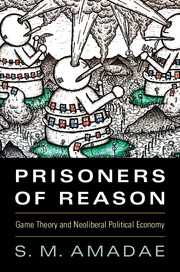3 - Assurance
from PART I - WAR
Published online by Cambridge University Press: 18 December 2015
Summary
We may now combine our analysis of PDs [Prisoner's Dilemmas] and commitment devices in discussion of the application that first made game theory famous outside of the academic community. The nuclear stand-off between the superpowers during the Cold War was exhaustively studied by the first generation of game theorists, many of whom worked for the US military … Both the USA and the USSR maintained the following policy. If one side launched a first strike, the other threatened to answer with a devastating counter-strike. This pair of reciprocal strategies, which by the late 1960s would effectively have meant blowing up the world, was known as ‘Mutually Assured Destruction’, or ‘MAD’. Game theorists objected that MAD was mad, because it set up a Prisoner's Dilemma as a result of the fact that the reciprocal threats were incredible.
Don Ross, 2014Some writings on international cooperation have applied game theory – particularly the Prisoner's Dilemma game – to security issues to identify the conditions under which cooperation is likely to emerge … [S]ecurity dilemmas … are often modeled as single play Prisoner's Dilemma.
Joseph S. Nye Jr. and Sean M. Lynne-Jones, 1988In the late 1940s and 1950s, defense intellectuals developed game theory to anchor military strategy in scientific analysis. The last chapter discussed how game theorists developed strategic rationality as a comprehensive science of decision making, which entailed plausibly identifying “a set of rules for each participant which tell him to behave in every situation which may conceivably arise,” and which was immediately developed for application to military and nuclear strategy. Analysts perceived that military strategy could not be contained by zero-sum game theory and John von Neumann's minimax concept of securing the least bad outcome for oneself. In the Prisoner's Dilemma model of bargaining, John Mayberry discovered that threatening the adversary with the worst outcome that one could credibly muster was the superior approach.
In 1960, Thomas Schelling used a Prisoner's Dilemma model to defend the nuclear strategy of mutual assured destruction (MAD). The Prisoner's Dilemma model of the nuclear security impasse implies that one actor's self-defense necessarily compromises the other's security because each has the first preference of achieving supremacy through preferring the outcome least acceptable to the opposition. Schelling's hope was that in addressing the worst-case scenario for achieving security, MAD would provide a blueprint for achieving peaceful coexistence in a nuclear age.
- Type
- Chapter
- Information
- Prisoners of ReasonGame Theory and Neoliberal Political Economy, pp. 69 - 98Publisher: Cambridge University PressPrint publication year: 2016



